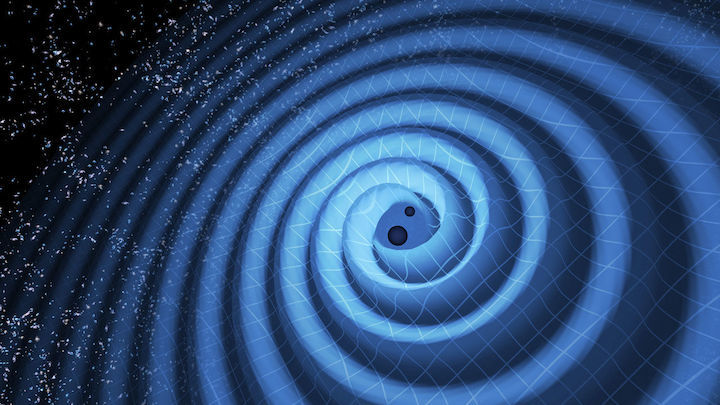20.04.2020

The gravitational waves from a black-hole merger typically ripple at twice the frequency that the black holes go around each other.
LIGO/T. PYLE
Researchers with the world’s gravitational wave detectors said today they had picked up vibrations from a cosmic collision that harmonized with the opening notes of an Elvis Presley hit. The source was the most exotic merger of two black holes detected yet—a pair in which one weighed more than three times as much as the other. Because of the stark mass imbalance, the collision generated gravitational waves at multiple frequencies, in a harmony Elvis fans would recognize. The chord also confirms a prediction of Einstein’s theory of gravity, or general relativity.
Such mismatched mass events could help theorists figure out how pairs of black holes form in the first place. “Anything that seems to be at the edge of our predictions is most interesting,” says Chris Belczynski, a gravitational theorist at the Polish Academy of Sciences in Warsaw, who was not involved in the observation. But the one event is “not quite in the regime where you can tell the different formation [routes] apart.”
Physicists first detected gravitational waves in 2015, when the Laser Interferometer Gravitational-Wave Observatory (LIGO), a pair of detectors in Washington and Louisiana, spotted two black holes spiraling into each other, generating infinitesimal ripples in spacetime. Two years later, the Virgo detector near Pisa, Italy, joined the hunt, and by August 2017, the detectors had bagged a total of 10 black hole mergers.
All involved pairs of black holes with roughly equal masses, says Maya Fishbach, a physicist and LIGO member at the University of Chicago. But on 12 April 2019, the three detectors detected a black hole merger 2.4 billion light-years away in which one weighed 30 solar masses and the other just eight, says Fishbach, who reported on the event at the American Physical Society’s online April meeting. “This is the first event in which we can confidently say the mass-ratio is not one,” she says.
Ordinarily, two spiraling black holes pump out gravitational waves concentrated at a single frequency: double the rate at which they orbit each other. That doubling arises because of the matched masses of the black holes. Every half orbit they return to a position that’s effectively identical to their original one. But if the black holes have distinctly different masses, then general relativity predicts that they should also generate weaker waves at higher frequencies, or overtones.
The next-strongest note sung by the pair should vibrate at three times the orbital frequency, or one and half times the main gravitational-wave frequency. If the main frequency were a C on a piano, the overtone would be the next higher G—a perfect fifth, and the interval of the first two notes in the melody of Elvis Presley’s hit “I Can’t Help Falling in Love with You.” That is what the LIGO and Virgo researchers detected, says Maximiliano Isi, a physicist and LIGO member at the Massachusetts Institute of Technology, who also spoke at the meeting. The overtone rang roughly as loudly as predicted by general relativity, Isi says. "Einstein prevails again."
Such oddball events might help researchers figure out how the black holes pair in the first place. That’s a puzzle because it’s not obvious how such big black holes can form so close together. Theorists have two general ideas. The pairs could originate from a pair of orbiting massive stars, which each collapse into black holes at the ends of their lives. Alternatively, in so-called dynamical models, the black holes might form completely separately and find each other across space and time, a scenario more likely in globular clusters, the dense clumps of stars found in the outer reaches of galaxies.
Either scenario can probably account for the mismatched black holes in this event, Belczynski says. “If it [the mass ratio] had been 10-to-1 I would have bet on the dynamical models,” he says, as binary star systems generally don’t form with such skewed ratios. Fishbach agrees that the single event isn’t enough to rule out one scenario or the other. But she says that if LIGO and Virgo spot more mismatched events, the statistical distributions could suggest which scenario is more likely.
However, the event could have a more complex origin, says Emanuele Berti, a gravitational wave astronomer at Johns Hopkins University. The fact that the one black hole is so much heavier than the other and appears to be spinning fast suggest that it, too, was the product of a merger. “It looks quiet like the product of a multiple-generation merger,” he says.
More peculiar collisions might be waiting among the dozens of recorded events that researchers have yet to analyze. LIGO and Virgo’s observing run 3, which went from 1 April 2019 until 26 March, picked up 56 new gravitational wave events, more than five times the previous total. LIGO and Virgo researchers had hoped to finish a global analysis of roughly half that data set by now, but the coronavirus pandemic delayed them, says Patrick Brady, a physicist at the University of Wisconsin, Milwaukee, and spokesperson for the LIGO scientific collaboration. Belczynski says he’s anxious to see those results. “I’m just sitting here with my students, my entire group, waiting for this paper.”
Quelle: AAAS
